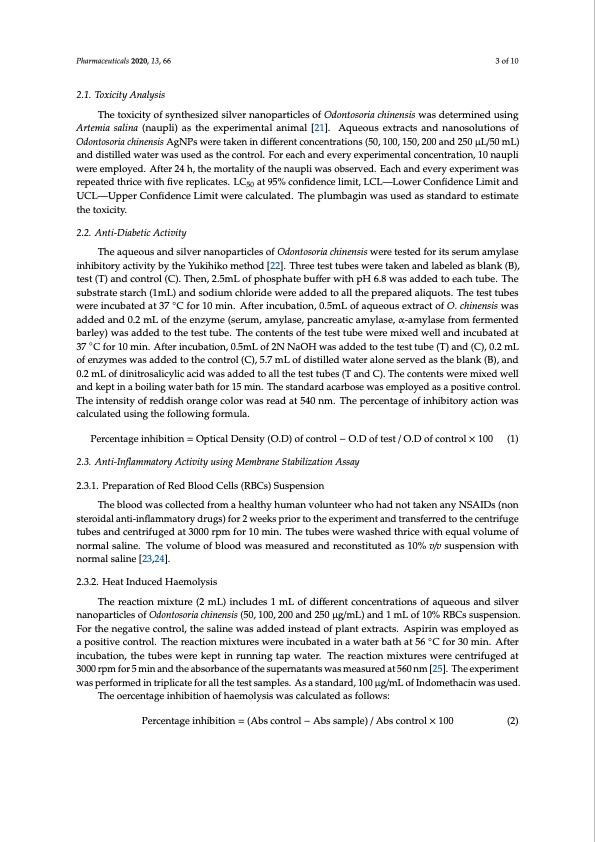
PDF Publication Title:
Text from PDF Page: 003
Pharmaceuticals 2020, 13, 66 3 of 10 2.1. Toxicity Analysis The toxicity of synthesized silver nanoparticles of Odontosoria chinensis was determined using Artemia salina (naupli) as the experimental animal [21]. Aqueous extracts and nanosolutions of Odontosoria chinensis AgNPs were taken in different concentrations (50, 100, 150, 200 and 250 μL/50 mL) and distilled water was used as the control. For each and every experimental concentration, 10 naupli were employed. After 24 h, the mortality of the naupli was observed. Each and every experiment was repeated thrice with five replicates. LC50 at 95% confidence limit, LCL—Lower Confidence Limit and UCL—Upper Confidence Limit were calculated. The plumbagin was used as standard to estimate the toxicity. 2.2. Anti-Diabetic Activity The aqueous and silver nanoparticles of Odontosoria chinensis were tested for its serum amylase inhibitory activity by the Yukihiko method [22]. Three test tubes were taken and labeled as blank (B), test (T) and control (C). Then, 2.5mL of phosphate buffer with pH 6.8 was added to each tube. The substrate starch (1mL) and sodium chloride were added to all the prepared aliquots. The test tubes were incubated at 37 ◦C for 10 min. After incubation, 0.5mL of aqueous extract of O. chinensis was added and 0.2 mL of the enzyme (serum, amylase, pancreatic amylase, α-amylase from fermented barley) was added to the test tube. The contents of the test tube were mixed well and incubated at 37 ◦C for 10 min. After incubation, 0.5mL of 2N NaOH was added to the test tube (T) and (C), 0.2 mL of enzymes was added to the control (C), 5.7 mL of distilled water alone served as the blank (B), and 0.2 mL of dinitrosalicylic acid was added to all the test tubes (T and C). The contents were mixed well and kept in a boiling water bath for 15 min. The standard acarbose was employed as a positive control. The intensity of reddish orange color was read at 540 nm. The percentage of inhibitory action was calculated using the following formula. Percentage inhibition = Optical Density (O.D) of control − O.D of test / O.D of control × 100 (1) 2.3. Anti-Inflammatory Activity using Membrane Stabilization Assay 2.3.1. Preparation of Red Blood Cells (RBCs) Suspension The blood was collected from a healthy human volunteer who had not taken any NSAIDs (non steroidal anti-inflammatory drugs) for 2 weeks prior to the experiment and transferred to the centrifuge tubes and centrifuged at 3000 rpm for 10 min. The tubes were washed thrice with equal volume of normal saline. The volume of blood was measured and reconstituted as 10% v/v suspension with normal saline [23,24]. 2.3.2. Heat Induced Haemolysis The reaction mixture (2 mL) includes 1 mL of different concentrations of aqueous and silver nanoparticles of Odontosoria chinensis (50, 100, 200 and 250 μg/mL) and 1 mL of 10% RBCs suspension. For the negative control, the saline was added instead of plant extracts. Aspirin was employed as a positive control. The reaction mixtures were incubated in a water bath at 56 ◦C for 30 min. After incubation, the tubes were kept in running tap water. The reaction mixtures were centrifuged at 3000 rpm for 5 min and the absorbance of the supernatants was measured at 560 nm [25]. The experiment was performed in triplicate for all the test samples. As a standard, 100 μg/mL of Indomethacin was used. The oercentage inhibition of haemolysis was calculated as follows: Percentage inhibition = (Abs control − Abs sample) / Abs control × 100 (2)PDF Image | Synthesis of Silver Nanoparticles Using Odontosoria chinensis

PDF Search Title:
Synthesis of Silver Nanoparticles Using Odontosoria chinensisOriginal File Name Searched:
pharmaceuticals-13-00066-v2.pdfDIY PDF Search: Google It | Yahoo | Bing
Turbine and System Plans CAD CAM: Special for this month, any plans are $10,000 for complete Cad/Cam blueprints. License is for one build. Try before you buy a production license. More Info
Waste Heat Power Technology: Organic Rankine Cycle uses waste heat to make electricity, shaft horsepower and cooling. More Info
All Turbine and System Products: Infinity Turbine ORD systems, turbine generator sets, build plans and more to use your waste heat from 30C to 100C. More Info
CO2 Phase Change Demonstrator: CO2 goes supercritical at 30 C. This is a experimental platform which you can use to demonstrate phase change with low heat. Includes integration area for small CO2 turbine, static generator, and more. This can also be used for a GTL Gas to Liquids experimental platform. More Info
Introducing the Infinity Turbine Products Infinity Turbine develops and builds systems for making power from waste heat. It also is working on innovative strategies for storing, making, and deploying energy. More Info
Need Strategy? Use our Consulting and analyst services Infinity Turbine LLC is pleased to announce its consulting and analyst services. We have worked in the renewable energy industry as a researcher, developing sales and markets, along with may inventions and innovations. More Info
Made in USA with Global Energy Millennial Web Engine These pages were made with the Global Energy Web PDF Engine using Filemaker (Claris) software.
Infinity Turbine Developing Spinning Disc Reactor SDR or Spinning Disc Reactors reduce processing time for liquid production of Silver Nanoparticles.
| CONTACT TEL: 608-238-6001 Email: greg@infinityturbine.com | RSS | AMP |